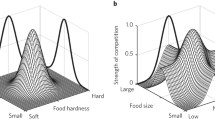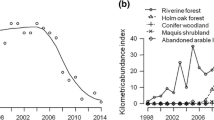Summary
One of the central assumptions of evolutionary ecology is that interspecific competition is a potent evolutionary force acting on coexisting species. There are few animal species that provide an opportunity for an experimental analysis of the evolutionary consequences of the phenomenon. We have taken advantage of the fact that two species of terrestrial salamander,Plethodon glutinosus andP. jordani, have different altitudinal distributions on two mountain ranges in North Carolina. Field removal experiments showed that interspecfic competition was much stronger in the Great Smoky Mountains than in the Balsam Mountains, and transplant experiments between the two mountain ranges showed that neither species from the Balsam Mountains had a measurable effect on its congener in the Smokies, although both species from the Smokies had strong negative effects on the Balsam congeners. Other experiments were conducted on the behavioral and ecological changes that have (or have not) evolved in the two areas. Our studies show that increased interspecific interference was the major evolutionary response of these largePlethodon species to interspecific competition, and that partitioning of food or microhabitat was not involved.
Similar content being viewed by others
References
Arnold, S. J. (1976) Sexual behavior, sexual interference and sexual defense in the salamandersAmbystoma maculatum, Ambystoma tigrinum andPlethodon jordani.Z. Tierpsychol. 42, 247–300.
Ayala, F. J., Gilpin, M. E. and Ehrenfeld, J. G. (1973) Competition between species. Theoretical models and experimental tests.Theor. Pop. Biol. 4, 331–56.
Burton, T. M. (1976) An analysis of the feeding ecology of the salamanders (Amphibia: Urodela) of the Hubbard Brook Experimental Forest, New Hampshire.J. Herp. 10, 187–204.
Case, T. J. and Gilpin, M. E. (1974) Interference competition and niche theory.Pr. Nat. Acad. Sci. (US) 71, 3073–7.
Cody, M. L. and Diamond, J. M. eds (1975)Ecology and Evolution of Communities. Harvard University Press, USA.
Connell, J. H. (1975) Some mechanisms producing structure in natural communities: a model and evidence from field experiments. InEcology and Evolution of Communities (M. L. Cody and J. M. Diamond, eds) pp. 460–90. Harvard University Press, USA.
Connell, J. H. (1983) On the prevalence and relative importance of interspecific competition: evidence from field experiments.Amer. Natur. 122, 661–96.
Davidson, J. A. (1956) Notes of the food habits of the slimy salamanderPlethodon glutinosus glutinosus.Herpetologica 12, 129–31.
Dayton, P. K. (1973) Two cases of resource partitioning in an intertidal community: making the right prediction for the wrong reason.Amer. Natur. 107, 662–70.
Dunn, E. R. (1926)The Salamanders of the Family Plethodontidae. Smith College 50th Ann. Pubs.
Fraser, D. F. (1976) Empirical evaluation of the hypothesis of food competition in salamanders of the genusPlethodon.Ecology 57, 459–71.
Gill, D. E. (1974) Intrinsic rate of increase, saturation density, and competitive ability. II. The evolution of competitive ability.Amer. Natur. 108, 103–16.
Hairston, N. G. (1949) The local distribution and ecology of the plethodontid salamanders of the southern Appalachians.Ecol. Monog. 19, 47–73.
Hairston, N. G. (1951) Interspecific competition and its probable influence upon the vertical distribution of Appalachian salamanders of the genusPlethodon.Ecology 32, 266–74.
Hairston, N. G. (1973) Ecology, selection and systematics.Breviora 414, 1–21.
Hairston, N. G. (1980a) The experimental test of an analysis of field distributions: competition in terrestrial salamanders.Ecology 61, 817–26.
Hairston, N. G. (1980b) Evolution under interspecific competition. Field experiments on terrestrial salamanders.Evolution 34, 409–20.
Hairston, N. G. (1981) An experimental test of a guild: salamander competition.Ecology 62, 65–72.
Hairston, N. G. (1983a) Alpha selection in competing salamanders: experimental verification of an a priori hypothesis.Amer. Natur. 122, 105–13.
Hairston, N. G. (1983b) Growth, survival and reproduction ofPlethodon jordani: trade-offs between selective pressures.Copeia 1983, 1024–35.
Hairston, N. G. (1986) Species packing inDesmognathus salamanders: experimental demonstration of predation and competition.Amer. Natur. 127, 266–91.
Hairston, N. G. and Pope, C. H. (1948) Geographic variation and speciation in Appalachian salamanders (Plethodon jordani) Group.Evolution 2, 266–78.
Hamilton, W. J. (1932) The food and feeding habits of some eastern salamanders.Copeia 1932, 83–6.
Highton, R. (1962) Geographical variation in the life history of the slimy salamander.Copeia 1962, 597–613.
Highton, R. (1972) Distributional interactions among eastern North American salamanders of the genusPlethodon. InThe Distributional History of the Biota of the Southern Appalachians (P. C. Holt, ed.) pp. 138–88. Res. Div. Monog. 4, Va. Poly. Inst. & State U.
Highton, R. (1983) A new species of woodland salamander of thePlethodon glutinosus group from the southern Appalachian Mountains.Brimleyana 9, 1–20.
Highton, R. and Henry, S. A. (1970) Evolutionary interactions between species of North American salamanders of the genusPlethodon.Evol. Biol. 4, 211–56.
Hutchison, V. H. (1959) Aggressive behavior inPlethodon jordani. Copeia 1959, 72–3.
Hutchinson, G. E. (1978)An Introduction to Population Ecology. Yale University Press, USA.
Jaeger, R. G. (1974) Interference or exploitation? A second look at competition between salamanders.J. Herp. 8, 191–4.
Jaeger, R. G. (1981) Dear enemy recognition and the costs of aggression between salamanders.Amer. Natur. 117, 962–74.
Jaeger, R. G. and Gergits, W. F. (1979) Intra- and interspecific communication in salamanders through chemical signals on the substrate.Anim. Behav. 27, 150–6.
Jaeger, R. G., Nishikawa, K. C. and Barnard, D. E. (1983) Foraging tactics of a terrestrial salamander: costs of territorial defense.Anim. Behav. 31, 191–8.
Jaeger, R. G., Goy, J., Tarver, M. and Marquez, C. E. (1986) Salamander territoriality: pheromonal markers as advertisement by males.Anim. Behav. 34, 860–4.
Jameson, E. W. Jr (1944) Food of the red-backed salamander.Copeia 1944, 145–7.
Lawlor, L. R. and Maynard Smith, J. (1976) The coevolution and stability of competing species.Amer. Natur. 110, 79–99.
MacArthur, R. H. (1972)Geographical Ecology. Harper & Row.
MacArthur, R. H. and Levins, R. (1967) The limiting similarity, convergence, and divergence of coexisting species.Amer. Natur. 101, 377–85.
MacArthur, R. H. and Wilson, E. O. (1967)The Theory of Island Biogeography. Princeton University Press, USA.
Nishikawa, K. C. (1985) Competition and the evolution of aggressive behavior in two species of terrestrial salamanders.Evolution 39, 1282–94.
Nishikawa, K. C. (1987) Interspecific aggressive behavior in salamanders: species-specific interference or misidentification?Anim. Behav. 35, 263–70.
Organ, J. A. (1958) Courtship and spermatophore ofPlethodon jordani metcalfi. Copeia 1958, 251–9.
Paine, R. T. (1966) Food web complexity and species diversity.Amer. Natur. 100, 950–61.
Pianka, E. R. (1976) Competition and niche theory. InTheoretical Ecology (R. M. May, ed.) pp. 167–96. Sinauer.
Powders, V. N. and Tietjen, W. L. (1974) The comparative food habits of sympatric and allopatric salamanders,Plethodon glutinosus andPlethodon jordani in eastern Tennessee and adjacent areas.Herpetologica 30, 167–75.
Roth, V. L. (1981) Constancy in the size ratios of sympatric species.Am. Nat. 118, 394–404.
Roughgarden, J. (1976) Resource partitioning among competing species — a coevolutionary approach.Theor. Pop. Biol. 9, 388–424.
Roughgarden, J. (1979)Theory of Population Genetics and Evolutionary Ecology: An Introduction. Macmillan.
Schoener, T. W. (1976) Alternatives to Lotka-Volterra competition: models of intermediate complexity.Theor. Pop. Biol. 10, 309–33.
Schoener, T. W. (1978) Effects of density-restricted food encounter on some single-level competition models.Theor. Pop. Biol. 13, 365–81.
Schoener, T. W. (1983) Field experiments on interspecific competition.Amer. Natur. 122, 240–85.
Siegel, S. (1956)Nonparametric Statistics. McGraw-Hill Book Co.
Simberloff, D. (1978) Using island biogeographic distributions to determine if colonization is stochastic.Amer. Natur. 112, 713–26.
Simberloff, D. (1983) Competition theory, hypothesis testing, and other community ecological buzzwords.Amer. Natur. 122, 626–35.
Wiens, J. A. (1977) On competition and variable environments.Amer. Sci. 65, 590–7.
Whitaker, J. O. Jr and Rubin, D. C. (1971) Food habits ofPlethodon jordani metcalfi andPlethodon jordani shermani from North Carolina.Herpetologica 27, 81–6.
Author information
Authors and Affiliations
Rights and permissions
About this article
Cite this article
Hairston, N.G., Nishikawa, K.C. & Stenhouse, S.L. The evolution of competing species of terrestrial salamanders: niche partitioning or interference?. Evol Ecol 1, 247–262 (1987). https://doi.org/10.1007/BF02067555
Issue Date:
DOI: https://doi.org/10.1007/BF02067555




